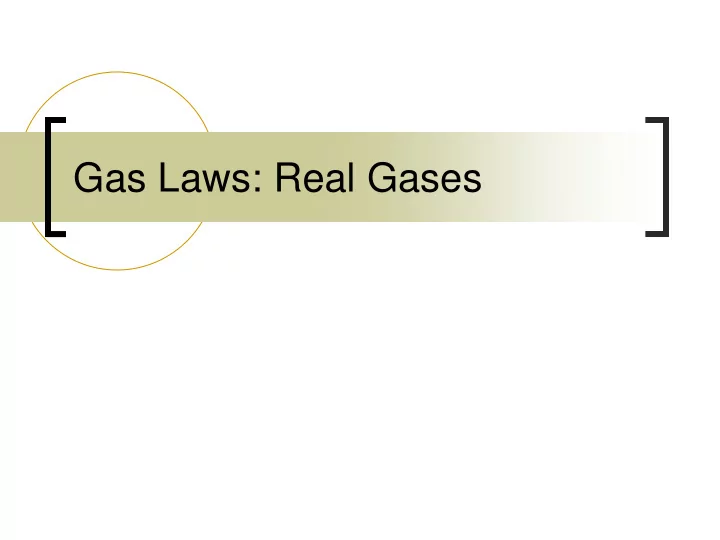

Gas Laws: Real Gases
Real Gases Real gases deviate from ideal gas law Quantify deviations using compressibility factor, Z. Z = PVbar/RT Z = 1 for ideal gas Need corrections to account for non- ideal behavior. Gas Laws CEM 484 2
van der Waals van der Waals adds two corrections to account for non-ideal behavior Probability to stick together during collision Volume of gas atoms attractive correction Probability for a molecule to stick after collision a[c]2 volume correction Account for volume taken up by molecules. Insert corrections into ideal gas law Gas Laws CEM 484 3
van der Waals Compressibility of van der Waals van der Waals constants are unique to each gas. a (L 2 bar 2 /mol 2 ) b (L/mol) He 0.034 0.024 N 2 1.35 0.039 CH 4 2.27 0.043 Gas Laws CEM 484 4
Intermolecular forces Two main forces contribute to non-ideal behavior in neutral molecules. Dipole-dipole forces: interaction between permanent electric dipole moments. Dispersion forces: no permanent electric dipole but interaction is through polarized valence electrons Iclicker: What is the correct ordering for the three gases CH 4 , N 2 , and He? A – a N2 > a CH4 > a He B – a CH4 > a N2 > a He A – a He > a N2 > a CH4 B – a CH4 > a He > a N2 Gas Laws CEM 484 5
Gas Density Performance of gas laws can be monitored using P vs. gas density curves Gas Laws CEM 484 6
Other gas laws Two other gas equations Redlich-Kwong Pen-Robinson Tabulated constants Gas Laws CEM 484 7
Critical Behavior Critical behavior explored on a P-V diagram. Critical point – temperature and pressure at which there is no distinction between gas and liquid – a fluid. Critical point on P- V ̅ isotherms Critical point defined by inflection point. Gas Laws CEM 484 8
Iclicker Assume someone told you that the following was an equation of state for a certain gas. RT B C P 2 3 V V V Using the definition of a critical point what is the critical molar volume in terms of the constants B and C? Gas Laws CEM 484 9
Recommend
More recommend